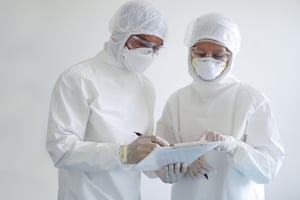 As part of the fire services first responder network, emergency medical services remain operational at a time when interpersonal contact puts the team and their families at risk. Yet, there are ways to minimize the chances of COVID-19 cross-infection. Here are five tips on how you can protect your staff and their families, and keep your station functioning during the COVID-19 pandemic:
As part of the fire services first responder network, emergency medical services remain operational at a time when interpersonal contact puts the team and their families at risk. Yet, there are ways to minimize the chances of COVID-19 cross-infection. Here are five tips on how you can protect your staff and their families, and keep your station functioning during the COVID-19 pandemic:
Educate the team on individual safety practices
Keeping your team safe and able to work, relies on their ability to follow the basic safety precautions shared with the public by the World Health Organization (WHO). While, as first responders, your team may have to take additional measures, grounding these on a strong foundation of basic precautions may increase their ability to fight off infection and remain in service. According to the WHO, these basic practices include:
- Frequently washing hands with soap and water, or using an alcohol-based hand sanitizer
- Maintaining a distance of at least 6 feet between yourself and others, when possible, and employing proper personal protective equipment (PPE) such as masks and gloves, when not possible.
- Avoiding touching your eyes, nose and mouth
- Practicing respiratory hygiene
- Seeking medical care early if presenting with a fever, cough or difficulty breathing
Implement infection prevention practices at the station
There’s more you can do than create a work environment that supports individual practices. The Occupational Safety & Health Administration (OSHA) has issued additional guidelines for preparing workplaces for COVID-19. This outlines the steps you can take to keep employees safe in low, medium and high-risk environments, and includes:
- Running job-specific training on preventing transmission in scenarios encountered while on duty
- Discouraging the sharing of equipment
- Maintaining regular housekeeping practices that include the cleaning and disinfection of surfaces and equipment
- Limiting visits by nonessential personnel
Plan for when someone tests positive for COVID-19
The OSHA source above also shares guidance on how to minimize the impact of a suspected or confirmed case of COVID-19 infection in the team. These include:
- Encouraging the team to self-monitor and report suspected symptoms immediately
- Prompt identification and isolation of anyone displaying symptoms
- Issuing the person displaying symptoms with a face mask until they can isolate
Administratively, OSHA also encourages the following:
- Developing a proactive plan to manage the potentially increased rates of absenteeism
- Ensuring sick leave policies are flexible and allow anyone displaying symptoms to stay home
Provide Emotional Support Services
The COVID-19 pandemic may also be taking an emotional and psychological toll on your team. While the focus remains on keeping the team physically safe at work and at home, extending your support beyond the workday and their physical health can help boost morale and keep generalized stress at bay. Some suggestions include:
- Encouraging staff to develop individualized self-care practices that can boost their wellbeing
- Allowing them to take time off to care for a loved one who may be infected with COVID-19
- Develop a database of referrals to community resources, such as telephonic counsellors, and refer distressed employees to relevant support networks
Observe strict safety protocols in the field
While your team may be practicing the best safety practices back at the station, they may be at unavoidably increased risk when responding to a call. Consider whether you may like to extend or adapt certain infection control practices to extend beyond the fire station. These may include:
- Providing the team with field-kits that allow for decontamination when responding to a call
- Routinely issuing anyone called out with a facemask or other relevant PPE to prevent possible cross-infection between the responder and members of the public
- Maintaining regular cleaning and disinfection of any vehicles and equipment used
Keeping the team safe when responding to an emergency call relies on more than just observing safety behaviors. Your team should also be able to rely on the equipment they use, without question. At Graham Medical, we’ve dedicated ourselves to support EMS workers by offering EMS products of the highest quality.
In addition, we provide a steady stream of up-to-date industry news. Keep your finger on the pulse of the latest EMS trends and developments by subscribing to our blogs.

